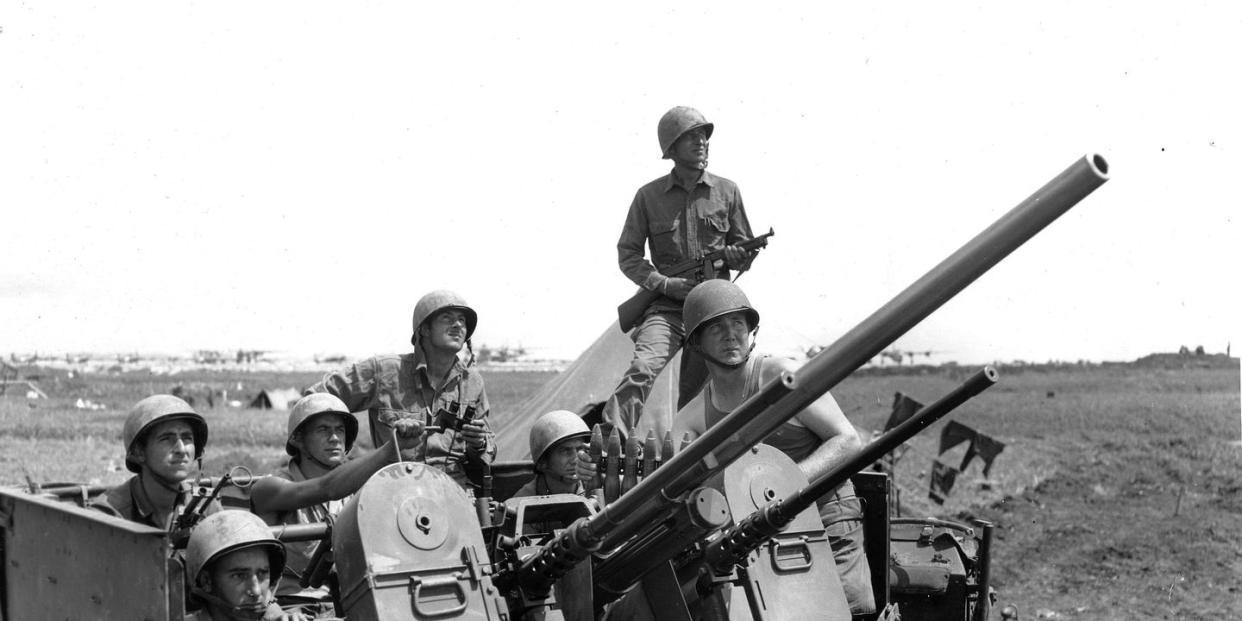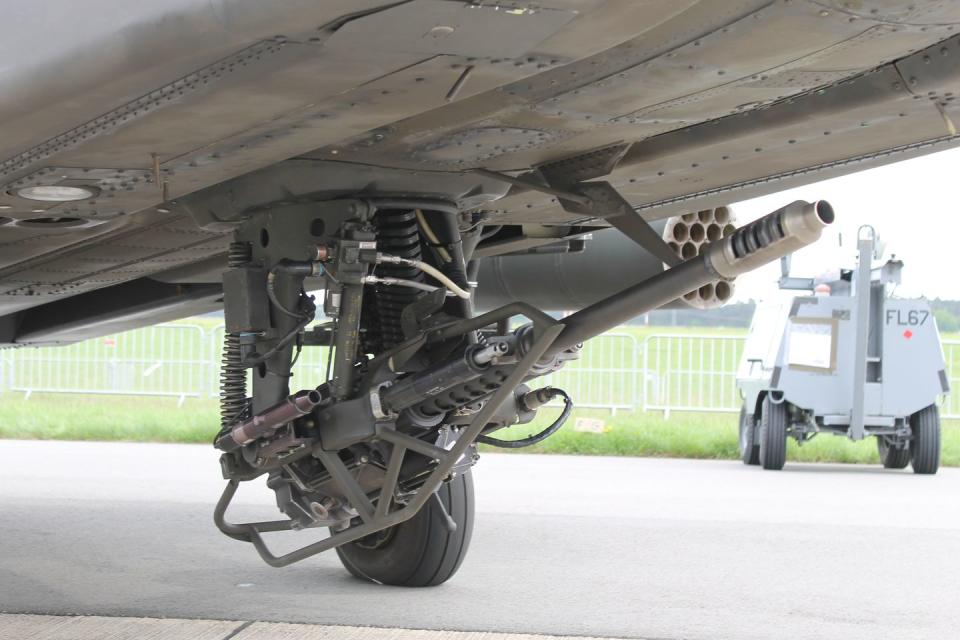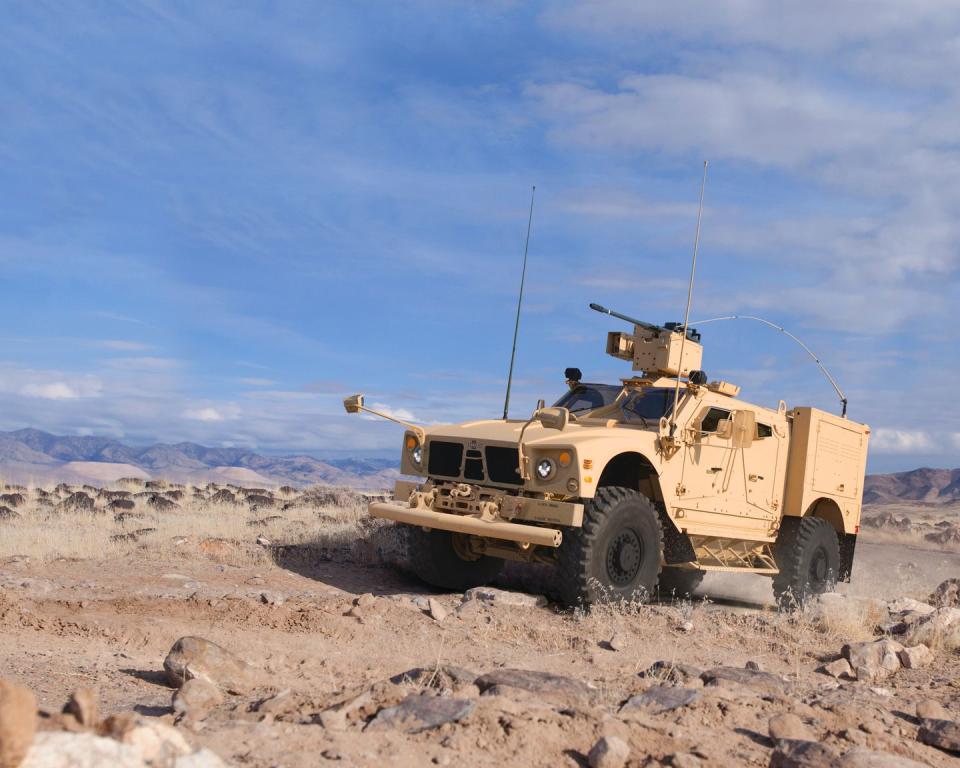America Is Slapping Cannons on Trucks to Help Ukraine Stop Russia's Killer Drones

On April 4, the Department of Defense announced its latest package of military aid to Ukraine, totaling $2.6 billion. This includes a class of weapon no longer used by U.S. ground forces—a self-propelled anti-aircraft gun going by the ugly acronym SPAAG—that will almost surely be put together specially for Ukraine.
The list of transfers states the U.S. is giving “nine counter-Unmanned Aerial System 30mm gun trucks”—in other words, a slightly Mad Max union of a truck with a rapid-firing autocannon to kill drones.
Their intended mission has been spelled out by defense officials: stopping Russian kamikaze drones, particularly cheap Iranian Shahed-136s used to assail Ukrainian cities.
Closer to—but not on—the frontline, there’s a need to protect against more capable tactical-range Lancet-3 kamikaze drones. These drones have been recorded destroying or damaging many Western-supplied long-range artillery systems.
Video of Russian Lancet loitering munition strikes on a Ukrainian Gyurza gunboat, two M109 howitzers in Kherson, and a 36D6 radar. 49/https://t.co/ZFniPLBsmPhttps://t.co/0o4B5VIYLh pic.twitter.com/tQKW0nify6
— Rob Lee (@RALee85) November 4, 2022
SPAAGs have fallen out of favor in Western armies, displaced by purely missile-based short-range air defense systems with better odds of hitting faster, higher-flying aircraft at greater distance. Post-Cold War, it’s also been assumed Western air power could be counted on to wipe out opposing warplanes early on, limiting the need for extensive ground-based air defenses.
Typical kamikaze drones move a lot slower than jet aircraft—slower than World War II warplanes even—but they are also orders of magnitude cheaper. That means the cost of a single portable Stinger air defense missile could be used to buy many Shahed-136s. And the cost disparity becomes absurd when employing longer-range anti-air missiles, like the $3 million a shot Patriot.
Old-school flak guns, therefore, remain quite effective at shooting drones down, and can do so affordably using lots of small cannon shells. The main technologies needed to bring them into the 21st century are appropriately scaled radars and/or infrared or electro-optical sights and rangefinders. These would help gunners detect the little aircraft in time, and have their weapons slewed into firing position as they approach a viable firing window.
Ukrainian troops have even been seen jerry-rigging commercial CCTV cameras and tablets to serve as improvised sights for old Yugoslavian flak guns. Presumably, the defense contractors hired by the Pentagon can improve on that.
While some SPAAGs are based on tank hulls to escort armored vehicles maneuvering on the frontline, Ukraine’s most pressing counter-drone air defenses are arguably behind the frontline, protecting population centers and valuable artillery units. For rear-area defense where the risk of coming under direct fire is lower, a lightly armored truck may do the job more efficiently than a tank-like SPAAG.
Short-range air defenses, of course, lack reach, and thus have to be spread out to provide “point defense” of specific targets likely to come under attack. That means just nine 30-millimeter gun trucks won’t make a big difference in a conflict this size. However, if this initial improvised trial order proves successful, it could become the pattern for a much larger-scale delivery of air defense gun trucks.
America’s Missing SPAAGs
During the World Wars—and throughout much of the Cold War—small, rapid-firing automatic cannons were highly effective means of air defense against low-flying ground attack aircraft and later helicopters. With the onset of mechanization, it made sense to mount these on trucks or armored vehicles so they could provide mobile defense for supply convoys and advancing columns that were especially vulnerable to air attack.
During World War II, the U.S. Army used the M15 and M16/M17 halftracks armed with 37 millimeter cannons and/or .50 caliber machine guns. In the Cold War, that was followed by the M19 and M42 Duster, based on the M24 and M41 light tanks respectively. Both were armed with dual 40-millimeter Bofors cannons.
In 1968, the finally Army introduced the M163 Vulcan Air Defense System (VADS), an M113 armored personnel carrier with an M168 20-millimeter six-barrel gatling cannon and AN/VPS-2 ranging radar bolted on. This could unleash a steady 1,000 rounds per minute (with 2,100 rounds carried) or shorter bursts at three times that firing rate, though its standard M246/A1 incendiary tracer round self-destructed after traveling 1.1 miles.
Post-Cold War U.S. air defense vehicles were used almost exclusively against ground targets in Korea, Vietnam, Panama and multiple Middle Eastern conflicts. An M163 claimed the downing of just one jet (a Syrian MiG-21) while in Israeli service.
The U.S. Army’s last attempt to field a SPAAG was the M247 Sergeant York, an expensive failure which never entered service. The Army instead focused on Stinger missile-launching Avenger Humvees and the now retired M6 Linebacker (based on the Bradley Fighting Vehicle), as well as towed C-RAM cannons used to protect bases by shooting down incoming rockets and mortars.
The German Flakpanzer Gepard (“Cheetah”) ended up being the last major Western SPAAG. 475 were built, and the Gepard was noted for its capable sensors, fire control and twin 35-millimeter guns. It was retired by Germany in 2010, but Ukraine has found its capabilities to be extremely valuable for battling Russian drones. Switzerland has refused to supply shells for the Gepard’s guns to Ukraine, so German firm Rheinmetall has restarted their production instead.
Chain Guns to the Rescue?
The U.S. military has primarily used smaller 20- or 25-millimeter guns on its warships and Army C-RAM close defense guns, the former with extreme rates of fire intended primarily to stop missiles, rockets and mortar shells.
The size difference between 20- and 30-millimeter ends up being larger than you’d think. Using the 30-millimeter involves accepting a lower rate of fire for a considerably extended range and harder-hitting punch, improving odds a near miss can still critically damage an aircraft. That’s an advantageous tradeoff for stopping drones.
The most likely weapon candidate to arm the U.S.-built trucks in Ukraine is the Mk44 Bushmaster II chain gun by Northrop-Grumman, an up-sized version of the 25-millimeter M242 gun on the Bradley Fighting Vehicle with 50% greater range.
A chain gun uses a loop of chain driven by an electric motor to cycle the weapon’s firing action, instead of gas or recoil forces released by a discharged round. The rate of fire, therefore, can be precisely controlled by accelerating or decelerating the speed of the chain, and isn’t susceptible to jamming due to a single misfired round.
The Army’s Stryker Dragoon wheeled infantry vehicles use the gun, as does the air defense variant, which also mounts Stinger and Hellfire missiles.
The U.S. Navy uses Mk44s on two turrets. The Mark 46 Mod 2 GWS turret is mounted on the Zumwalt-class stealth destroyer, both types of surface-warfare configured littoral combat ships (LCSs), and San Antonio-class dock landing ships (LSDs).
The MK38 Mod 4 turret is replacing prior 25-millimeter-armed MK38 turrets on Arleigh Burke-class destroyers, and slated for forthcoming Coast Guard Polar Security Cutters. They can optionally mount a co-axial M2 .50-caliber machine gun, and can even be manually operated in if necessary. The Mod 4 was specifically billed in defense procurement documents as capable of countering drone threats.
The naval Mk44 mounts can spit out 200 round per minute out to an effective range of 3.1 miles. Both use dual-feed ammunition systems allowing loading of two different types of ammunition—with a capacity of 400 rounds—and integrate a laser rangefinder, stabilized electrooptical/thermal sensors and camera sights. An HEP shell, proximity-fused so as to air-burst when close to drones, has also been specifically devised for the naval Mk44s.
Mk44-armed vehicles donated to Ukraine have their uses. This weapon is the main gun on Polish Rosomak fighting vehicles Ukraine is receiving. It’s also used on certain subvariants of Swedish CV-90 and Stryker vehicles bound for Kyiv, though the Stryker vehicles are not guaranteed to be Mk44-armed types.
Another possibility is Northrop-Grumman’s M230 chain gun, most famously used on a chin turret on the Apache attack helicopter, and more obscurely on special MH-60L DAP Black Hawks operated by Special Ops aviation. This attains a much higher rate of fire of roughly 600 round per minute (or 10 per second), though half that is more realistic. Its 30x113mm shells, however, travel at a 20% lower muzzle velocity and range; on the plus side it is compatible with European ADEN and DEFA 30-millimeter rounds.

In recent years, M230s are showing up on wheels too, notably including the eight-wheeled Stryker M-SHORAD—designed for battling drones, but definitely not a “truck.” But what should qualify are experiments installing an M230LF/XM914 (which has a reduced firing rate of 200 rpm) on a JLTV, the Pentagon’s intended successor to the Humvee.
The Marine Corps has retired its Stinger-armed Avenger Humvees and plans to replace them with a duo of JLTVs. The first—the Kongsberg RWS6 or MADIS MK1—has a remotely operated turret armed with both Stingers and an XM914 chain gun and electro-optical sensors, while the second (MADIS Mk2) has a radar and a M134 minigun (a rifle-caliber gatling weapon).

Truck-builder Oshkosh and missile-maker Orbital ATK have also demonstrated a prototypes of the former company’s M-ATV and L-ATV mine-resistant ambush-protected vehicles (MRAP) on a remote weapon station equipped with a fully stabilized XM914—a combo weighing just over a half-ton all told. Such M230-based remote weapon stations also appear to have been successfully mated to a Toyota pickup truck--a classic improvised heavy weapons platform.
An unlikely alternative to the chain guns is the massive seven-barreled GAU-8 Avenger gatling cannon used by A-10 attack jets, which was adapted by the Dutch into the naval Goalkeeper CIWS close-defense weapons. In addition, it’s not impossible the U.S. might source 30-millimeter guns from abroad for expediency, which would open many additional options.
Modern warplanes continue to have more and more tools to avoid entering the range of SPAAGs. And more expensive missile-armed UCAV drones can also fly above their effective range. But slow and low flying kamikaze drones with the potential to swarm in large numbers are beginning to pose a serious threat. For that matter, rapidly detecting and affordably killing surveillance/artillery spotting drones like Russia’s Orlan-10 is vital, as they are key to facilitating deadly attacks from kamikaze drones or artillery.
Thus, the supposedly obsolete SPAAG is making something of a comeback. But it may be short-lived, as alternative solutions such as laser-guided rockets and, soon, even just plain-old lasers, move to the forefront of military tech.
You Might Also Like

